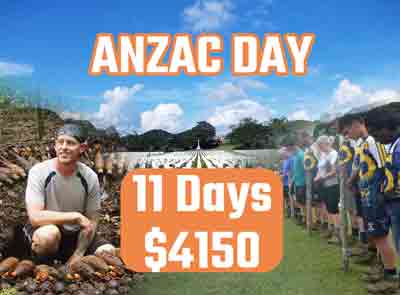Australian / Papua New Guinea Buna Gona and the Pacific War : The Battle of Buna–Gona and Battle of the Beachheads – November 1942
The Kokoda Track, a challenging terrain etched in history for its significance during the Papua New Guinea campaign in the Pacific War, bears witness to the indomitable spirit of Australian forces engaged in jungle warfare. Among the pivotal battles fought along the Kokoda Track, the Battle of Buna Gona stands as a testament to courage, sacrifice, and the tenacity of Allied forces. In this article, we delve into the events surrounding this historic battle, exploring its connection to the Kokoda Campaign and the strategic significance it held.
Kokoda Campaign Unfolds
The Kokoda Campaign, a critical chapter in the Pacific War, kicked off in July 1942 when Japanese forces landed near Buna, marking the beginning of their advance toward Port Moresby. The Australian and United States forces faced the daunting task of defending against the relentless Japanese onslaught.
Battle of Buna Begins
On 16 November 1942, the Battle of Buna commenced as Australian forces clashed with the Japanese along the Buna-Gona area. The dense jungle became the battleground for the Australian 7th Division, committed to halting the Japanese advance and turning the tide of the battle in the Allies’ favour.
Jungle Warfare Challenges
The Buna-Gona area presented unique challenges, with its unforgiving jungle terrain making the trekking and hiking conditions arduous for both sides. The Australian infantry, seasoned in jungle warfare, faced Japanese forces determined to defend their positions.
Battle of Buna-Gona and Kokoda Connection
The Battle of Buna Gona was intricately connected to the Kokoda Campaign. The success of the Allies in Buna was crucial for securing the beachheads and disrupting Japanese beachheads, a strategy closely tied to the overall objectives of the Kokoda Track defence.
Heavy Casualties and Heroic Efforts
The Australian forces, while valiant, suffered heavy casualties during the battle. The casualties mounted as the fighting intensified, with Buna village becoming a focal point of the conflict. The sacrifice of the infantry regiments and Australian soldiers would later be commemorated at the Australian War Memorial.
Turning the Tide: January 1943
The battle raged on for months, but by 22 January 1943, the Allies, including Australian forces, achieved a significant victory in Buna. The capture of Buna marked a turning point in the New Guinea campaign, showcasing the resilience of the Allied forces in the face of adversity.
Legacy of the Battle of the Beachheads
The Battle of Buna Gona, often referred to as the Battle of the Beachheads, played a pivotal role in securing the Buna-Gona area and setting the stage for subsequent offensives in the Pacific War. The commitment of Australian forces and their victory in Papua added another chapter to the larger narrative of the war in the Pacific.
Conclusion: Remembering the Sacrifice
As trekkers embark on the challenging journey along the Kokoda Track, the echoes of the Battle of Buna Gona reverberate through the dense jungles. The courage displayed by the Australian forces, the heavy casualties suffered, and the ultimate victory stand as a testament to the sacrifices made in the name of freedom. The trekking experience becomes not just a physical challenge but a pilgrimage to honor the memory of those who fought valiantly in the pivotal battles of Buna-Gona during the Kokoda Campaign.
Q: What were the Battle of Buna–Gona and the Battle of the Beachheads?
A: The Battle of Buna–Gona and the Battle of the Beachheads were significant military operations fought between the Allied forces and the Japanese forces in the Buna area of Papua New Guinea in December 1942.
Q: Who were the main participants in the Battle of Buna–Gona and the Battle of the Beachheads?
A: The main participants were the Australian 7th Division, the American 32nd Division, and the Japanese forces defending the Buna area.
Q: What were the objectives of the Allied forces in the Battle?
A: The Allied forces aimed to capture the Buna–Gona area, which was a vital Japanese position in New Guinea, to prevent the Japanese from using it as a staging point for further offensives.
Q: How long did the Battle of Buna–Gona and the Battle of the Beachheads last?
A: The battles began in late November 1942 and continued until January 1943, resulting in several weeks of intense and arduous fighting.
Q: What role did the 32nd Division play in the Battle?
A: The American 32nd Division played a crucial role in the battle, particularly in the fighting at Gona and Sanananda, as well as in securing the beachheads at Buna.
Q: What was the significance of the Battle in World War II?
A: The battles were significant as they marked the first land victory by the Allied forces against the Japanese in the Pacific War, and they also demonstrated the challenges of jungle warfare.
Q: How were the Japanese bunkers overcome?
A: The Japanese bunkers at Buna–Gona were overcome through a combination of infantry assaults, artillery bombardment, and strategic flanking maneuvers by the Allied forces.
Q: What impact did the Battle have on the overall war against Japan?
A: The success at Buna–Gona boosted the morale of the Allied forces and marked a turning point in the war in the Pacific, creating momentum for future offensives against the Japanese in the region.
Q: What was General Eichelberger’s role at Buna–Gona?
A: General Robert L. Eichelberger played a crucial leadership role in the Allied operations at Buna–Gona, providing strategic direction and coordinating the combined Australian and American forces.
Q: How did the Battle contribute to the eventual defeat of the Japanese forces in the Pacific?
A: The Battle of Buna–Gona contributed to the gradual weakening of the Japanese position in the Pacific, ultimately playing a part in the overall defeat of the Japanese forces in the region.




